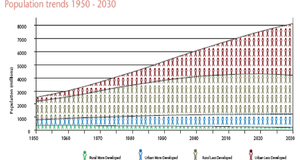Environmental Sustainability in China: A Historical Perspective
By
2009, Vol. 1 No. 11 | pg. 1/1
KEYWORDS:
It is no secret that China today faces serious environmental challenges. The combination of a rapidly growing population and a lack of viable communication between the state and local communities have produced a difficult situation. Many argue, from Malthusian terms, that overpopulation is the simple answer to a host of problems, embedded in historical and contemporary events. While the size of China's population is troubling to say the least, it is not the sole cause of environmental degradation through resource consumption. The distribution of resources across social classes of the population results in the abandonment of many rural communities and the establishment of inefficient and harmful methods of resource consumption. Harmful methods of resource management and consumption have reached a level at which the environment will suffer exponentially. Nevertheless, it is these destructive modes of resource management on which China depends for food supplies, and it is through these same modes that China has starved itself in the past and may starve itself again in the future.Overpopulation is often seen as the cause of China’s environmental problems. Those who support this theory argue that China cannot cope with the recent rapid growth in distributing resources to its population. This coupled with recent estimates about the continued growth of the nation create alarming forecasts for the resilience and sustainability of China’s environment. Robert Solow characterizes sustainability as “an injunction not to satisfy ourselves by impoverishing our successors.” (Solow:181) In this light it is clear that China is at a crucial point in time. With disparities between rural and urban well being so large given the current population it is even more troubling to consider the problems given the current growth of China’s population. If China’s population hopes to meet the needs of the growing population it needs to radically alter its current methods of resource management on a large scale. This type of revolution will almost certainly demand the intervention and help of the government. The resilience of the environment to the continued demands of the population is reaching its limit. The system upon which the population relies upon to reap the fruits it requires, is becoming less and less able to recover from the stresses it experiences. Without the work of the government in distributing resources to rural areas, China will find itself locked in to a destructive system. While overpopulation is a central part of the problem it offers very few solutions. China’s family planning program and low fertility rate hope to reduce population growth but the lack of compliance in rural areas will continue to increase population. Overpopulation is not the only solution to today’s problems and it has not been the only cause of historical crisis. Looking back it is possible to find examples of the disagreement of interests between local and government agencies in regulating resource management. These examples illustrate the beginning of such trends in China where local and state authorities do not work well together in establishing consistent systems of land use. Peter Purdue discusses examples of these inconsistent relationships. In “Food, Famine, and the Chinese State” Perdue analyzes cases in the Dongting Lake region during the Ming and Qing dynasties. Dike building was then, and is now, an integral part of the agricultural system. Perdue illustrates how dike building and necessary repairs were met with inconsistent success. “Community organization of waterworks construction and repair proved inadequate, because individual incentives contradicted collective needs. At times, this intervention [local official] was successful..but the dialectic of official initiative and community response did not always function smoothly.” (Perdue: 751-752) Repairs and construction were often tied up in local bureaucratic tape that the state, represented by a local official, was only seldom able to create temporary solutions. Perdue is careful to note that overpopulation was a catalyst to these problems, but poor planning and control ultimately led to the problems the dikes faced. When dikes were improperly repaired or constructed it would often lead to flooding and further destruction of the land. Often when the state attempted to intervene in order to prevent floods and land destruction it was met with local resistance. Local communities would continue to build private dikes that were not sanctioned by the state in an effort to continue to expand the area of cultivable land and overall well-being. “Local elites could use their influence on local officials to get them to collude in concealing illegal dikes from higher authorities.” (Perdue: 756) Unfortunately this mismanagement led to environmental crisis. The corruption of local officials coupled with finger pointing responsibility of dike repair between individuals and collectives created a disastrous system. The lake flooded and redistributed silt creating new land that ultimately narrowed the lake and made it more unstable. “The major manmade cause of the disastrous flood of 1931 was attributed to excessive land clearance that blocked vital drainage routes.” (Perdue: 757) Resources between the local farmers, local elite leaders, and the state were far from evenly distributed. Ultimately it would be the local farmers that would suffer as a result of the lack of successful management of those in power, both unofficially and officially. In other words it was the wealthy portions of the population who sought to expand the situation beyond its resilience and the states inadequate ability to prevent and manage these exploitations. “The Qing court did not allow officials to excuse themselves by blaming natural forces. Major floods were considered to be a result of maladministration.” (Perdue: 758) If poor management had been avoided and alternate solutions had been conceived for the growing problems in the Dongting Lake region disaster might have been averted or at least subdued. “If Hunanese officials…had been able to promote unreservedly further land clearance around the lake, they could have used the surplus produced by land clearance to satisfy these conflicting demands and thus prevent the [hunger] riots.” (Perdue: 762) Lack of authoritative government control was evident far before the problems in Dongting Lake during the Qing and Ming dynasties. Keith Schoppa brings to light similar problems involving the struggle between local farmers and officials as well as elite land owners in the Xiang Lake during the Song dynasty. The lake had been reconstructed in order to provide flood control and irrigation opportunities for surrounding communities. Though the plan was met with initial success; it soon fell victim to the encroachment of elite landowners seeking to build on land that was revealed during a low point in the lakes fluctuation. “In 1167 three higher level officials colluded with some men around the lake to transform lake into land for private use.” (Schoppa: 17) The local official attempted to appeal to the higher factions of the government but was met with little help. “The formal ‘solution’ provided a way for those [officials] in Hangzhou to express concern for the people of Xiang Lake, while the substance-failing to take substantive action against the indicted-gave evidence of the equation of political power at the capital.” (Schoppa: 18) Once land encroaching began and was not truly enforced it opened up the gates for a wave of emigration to lands around the lake. Continued encroachment led to the narrowing of the lake and the increased instability of the dike systems and irrigation control. Ultimately flooding and destruction became a cycle that locked in the local populations to a system of degradation and destruction. Examples from the Xiang Lake and Dongting Lake regions illustrate a pattern of poor administrative ability to manage the distribution of resources in a consistent and sustainable system. Sustainability as defined by Solow was described as, “an injunction not to satisfy ourselves by impoverishing our successors.” (Solow:181) Not only do these examples show how each generation neglected to provide adequate reliable resources for their successors but it shows that the government allowed a pattern to occur in which the needs of the landowning elite were able to squander their power and usurp resources for their own benefit. The lack of government enforcement in these corrupt systems allowed the cycle of resource mismanagement to continue until the environment could no longer accept the impact that the local population was placing on it. By not enforcing measures that would adequately distribute land and resources to all aspects of the community both wealthy and poor the state not only allowed but required the continued degradation of the environment through inefficient agricultural and water works projects. Had the state been able to effectively enforce containment of water works projects and land encroachment while providing alternate resources for those communities who required them many locked in disaster cycles may have been averted. Robert Marks highlights a situation in Lingnan in which the practices of peasant farmers greatly degrade the environment because of poor resource management with no state intervention. The advent of new world crops had allowed many peasants to use the ample mountainous land to grow crops such as potatoes. This allowed for much needed resources in areas that arable land was in short supply. The practice of burning forested areas to provide nutrients for the soil was in full swing coupled with crop rotation. At the same time there was a shortage of firewood such that even more forests were harvested or alternate fuel supplies were utilized. Marks comments on the contradiction between burning forests and the shortage of fuel. “Given the fuel shortage noted earlier, the practice of burning off the hillsides appears somewhat curious, since it would appear to waste a valuable resource.” (Marks: 321) Not only were valuable resources wasted but the forests were not replanted. If proper replanting techniques had been enforced it may have created a renewable source of land for crops and fuel. Not only did the deforestation create loss of forest land and the degradation of animal species such as the tiger, it created a situation in which water runoff was increased on the burned slopes which exacerbated flood problems. Problems such as these are increased when you consider the role of population. As more people are born they require more resources and therefore more resources are taken out of the environment. Some would argue that overpopulation is the driving problem in Chinese environmental problems as a result of the inability of the environment to maintain its resilience to such drastic surges. I would contend that overpopulation is a serious problem but it is still a problem that has risen out of mismanagement and unequal distribution among resources that has helped to create it. Taking the family planning plan as an example we can see how such a relationship could occur. The plan was put into effect to control China’s population and yet even today we see a much higher compliance and fertility rates closer to one in the urban areas compared to higher fertility rates in the rural populations. “Compliance was at least initially a consequence largely of urban dependence on the state for employment, residence, education and other such benefits. In rural China where there is no such dependence, there is also no such compliance.” (Fertility: 95) The population continued to grow because urban areas were given incentives to adhere to the family planning program while the rural areas were not able to access the same resources. Rural China has a dependence on children for “familial labor and old age support” such that following the family planning program would be a detriment to their ability to survive. It seems that poor practices and maldistribution of resources have been the pattern for the last several centuries of China’s economy. The increasing pressure on a growing population forces peasants to seek new methods of recovering resources. The lack of state intervention in monitoring and enforcing sustainable resource management created several ‘locked-in’ systems. These systems force peasants to continue degrading the environment in order to provide for families and demanding markets. Ultimately it is the lack of state control that causes these problems while overpopulation heavily increases the impact of such poor practices. The Great Leap Forward is a tragic example of the way in which government control can violate the needs of the population. The forced industrialization plan removed vital labor for agricultural needs and left millions of Chinese peasants without food. These same poor policies have been plaguing Chinese economy and environment for centuries at the price of the well being of the poor peasant populations of China. ReferencesSolow, Robert. "Sustainability: An Economist's Perspective." Eighteenth J. Seward Johnson Lecture. Woods Hole Oceanographic Institution, Woods Hole, MA. 14 June 1991. Perdue, Peter. "Water Control in the Dongting Lake Region during the Ming and Qing Periods." Journal of Asian Studies XLI(1982): 747-765. Schoppa, Keith. Song Full of Tears: Nine Centuries of Chinese Life Around Xiang Lake. Cambridge, MA: Yale University Press, 1989. Marks, Robert. Tigers, Rice, Silk, & Silt. Cambridge, Ma: Cambridge University Press, 1998. Lee, James, and Wang Feng. One Quarter of Humanity: Malthusian Mythology and Chinese Realities, 1700-2000. Harvard University Press, 2001. Suggested Reading from Inquiries Journal
Inquiries Journal provides undergraduate and graduate students around the world a platform for the wide dissemination of academic work over a range of core disciplines. Representing the work of students from hundreds of institutions around the globe, Inquiries Journal's large database of academic articles is completely free. Learn more | Blog | Submit Latest in Environmental Studies |


















